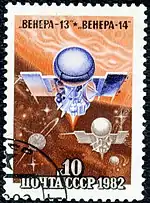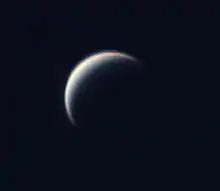Venera 13
Venera 13 (Russian: Венера-13 meaning Venus 13) was a probe in the Soviet Venera program for the exploration of Venus.
 Postage stamp of Venera 13/14 | |
| Mission type | Venus flyby / lander |
|---|---|
| Operator | Soviet Academy of Sciences |
| COSPAR ID | 1981-106A 1981-106D |
| SATCAT no. | 12927 15599 |
| Mission duration | Travel: 4 months, 2 days Lander: 127 minutes |
| Spacecraft properties | |
| Spacecraft type | 4V-1 no.760 |
| Manufacturer | NPO Lavochkin |
| Launch mass | 4,397.85 kilograms (9,695.6 lb) |
| Landing mass | 760 kg (1,680 lb) |
| Dry mass | 1,643.72 kg (3,623.8 lb) |
| Dimensions | 2.7 m × 2.3 m × 2.7 m (8.9 ft × 7.5 ft × 8.9 ft) |
| Start of mission | |
| Launch date | October 30, 1981, 06:04:00 UTC |
| Rocket | Proton-K/D-1 8K82K |
| Launch site | Baikonur 200/40 |
| End of mission | |
| Last contact | lander: March 1, 1982 / carrier: at least until April 25, 1983 |
| Orbital parameters | |
| Reference system | Heliocentric |
| Eccentricity | 0.17 |
| Perihelion altitude | 0.70 AU |
| Aphelion altitude | 0.99 AU |
| Inclination | 2.3 degrees |
| Period | 285 days |
| Flyby of Venus | |
| Spacecraft component | Venera 13 flight platform |
| Closest approach | March 1, 1982 |
| Distance | ~36,000 kilometres (22,000 mi) |
| Venus lander | |
| Spacecraft component | Venera 13 descent craft |
| Landing date | 03:57:21, March 1, 1982 |
| Landing site | 7.5°S 303°E (east of Phoebe Regio) |
Venera 13 and 14 were identical spacecraft built to take advantage of the 1981 Venus launch opportunity and launched 5 days apart, Venera 13 on 30 October 1981 at 06:04 UTC and Venera 14 on 4 November 1981 at 05:31 UTC, both with an on-orbit dry mass of 760 kg (1,680 lb).
Design
Each mission consisted of a cruise stage and an attached descent craft.
Cruise stage
As the cruise stage flew by Venus the bus acted as a data relay for the lander and then continued on into a heliocentric orbit. It was equipped with a gamma-ray spectrometer, UV grating monochromator, electron and proton spectrometers, gamma-ray burst detectors, solar wind plasma detectors, and two-frequency transmitters which made measurements before, during, and after the Venus flyby. "The bus continued to provide data until at least 25 April 1983."[1]
Descent lander
The descent lander was a hermetically-sealed pressure vessel, which contained most of the instrumentation and electronics, mounted on a ring-shaped landing platform and topped by an antenna. The design was similar to the earlier Venera 9–12 landers. It carried instruments to take chemical and isotopic measurements, monitor the spectrum of scattered sunlight, and record electric discharges during its descent phase through the Venusian atmosphere. The spacecraft utilized a camera system, an X-ray fluorescence spectrometer, a screw drill and surface sampler, a dynamic penetrometer, and a seismometer to conduct investigations on the surface.
List of lander experiments and instruments:
- Accelerometer, Impact Analysis - Bison-M
- Thermometers, Barometers - ITD
- Spectrometer / Directional Photometer - IOAV-2
- Ultraviolet Photometer
- Mass Spectrometer - MKh-6411
- Penetrometer / Soil ohmmeter - PrOP-V
- Chemical Redox Indicator - Kontrast
- 2 Color Telephotometer Cameras - TFZL-077
- Gas Chromatograph - Sigma-2
- Radio / Seismometer - Groza-2
- Nephelometer - MNV-78-2
- Hydrometer - VM-3R
- X-Ray Fluorescence Spectrometer (Aerosol) - BDRA-1V
- X-Ray Fluorescence Spectrometer (Soil) - Arakhis-2
- Soil Drilling Apparatus - GZU VB-02
- Stabilized Oscillator / Doppler Radio
- Small solar batteries - MSB
Landing
After launch and a four-month cruise to Venus the descent vehicle separated from the cruise stage and plunged into the Venusian atmosphere on 1 March 1982. After entering the atmosphere a parachute was deployed. At an altitude of about 50 kilometres (31 mi) the parachute was released and simple airbraking was used the rest of the way to the surface.
Venera 13 landed at around 7–8 m/s at 7.5°S 303°E, about 950 km (590 mi) northeast of where Venera 14 would land several days later, just east of the eastern extension of an elevated region known as Phoebe Regio.[2]
The lander had cameras to take pictures of the ground and spring-loaded arms to measure the compressibility of the soil. The quartz camera windows were covered by lens caps which popped off after descent.[3][4]
The area was composed of bedrock outcrops surrounded by dark, fine-grained soil. After landing, an imaging panorama was started and a mechanical drilling arm reached to the surface and obtained a sample, which was deposited in a hermetically sealed chamber, maintained at 30 °C (86 °F) and a pressure of about 0.05 atmosphere (5 kPa). The composition of the sample determined by the X-ray fluorescence spectrometer put it in the class of weakly differentiated melanocratic alkaline gabbroids.
The lander functioned for at least 127 minutes (the planned design life was 32 minutes) in an environment with a temperature of 457 °C (855 °F) and a pressure of 89 Earth atmospheres (9.0 MPa). The descent vehicle transmitted data to the satellite, which acted as a data relay as it flew by Venus.
Microphones on the probe recorded atmospheric wind noises in an effort to measure wind speed (they also recorded noises associated with the probe's equipment).[5] This was the first recording of sound on another planet. The recording would be repeated with Venera 14.
Suggested photographic evidence of life
Leonid Ksanfomaliti[:ru] of Space Research Institute of the Russian Academy of Sciences (a contributor to the Venera mission) and Stan Karaszewski of Karas, suggested signs of life in the Venera images in an article published in Solar System Research.[6] According to Ksanfomaliti, certain objects resembled a "disk", a "black flap" and a "scorpion" which "emerge, fluctuate and disappear", referring to their changing location on photographs and traces on the ground.[7][8][9][6]
Engineers familiar with the probe have identified the moving "disk" as actually being the two lens caps ejected from the lander. Rather than a single object that had moved between two places, they are simply two inanimate similar-looking objects in different places. The other "objects" are ascribed to image processing artifacts and do not appear in the original photography.[10]
The editors of Solar System Research published an editorial comment and a number of commentary articles from other scientists in their September 2012 publication of Issue 5, Volume 46 of the journal. That issue also includes a second article from Ksanfomaliti, in which he claims to identify several other life forms and speculates regarding the apparent rich diversity of life around the landing site.
These claims have been refuted by the Live Science website.[11]
Post encounter
The spacecraft bus ended up in a heliocentric orbit where it continued to make observations in the X-ray and gamma ray spectrum.[12] To provide data for the later Vega mission the bus activated its engine on the 10 June 1982.[12] The last data published for the probe is from 12 April 1983.[12]
In fiction
- The Venera 13 lander appears in the short film Horses on Mars (2001) with a message to the main character who is a microbe lost on Venus.
- The Venera lander appears in the book "Contact" (Sagan, 1985).
See also
References
- https://www.nasa.gov/connect/ebooks/beyond_earth_detail.html
- "NSSDC Master Catalog - Venera 13 Descent Craft". NASA National Space Science Data Center. Retrieved 13 April 2013.
- "Murphy's Law (part two)". great moments in science. Retrieved 2019-08-06.
- "Images". Images of the surface of Venus. Retrieved 2019-08-06 – via www.donaldedavis.com.
- Ksanfomaliti, L.V.; Goroshkova, N.V.; Naraeva, M.K.; Suvorov, A.P.; Khondryev, V.K.; Yabrova, L.V. (July–August 1982). "Acoustic Measurements of the Wind Velocity at the VENERA-13 and VENERA-14 Landing Sites". Soviet Astronomy Letters. 8: 227–229. Bibcode:1982SvAL....8..227K. Translation of Pis'ma v Astronomicheskii Zhurnal (in Russian). 8: 419–423. July 1982. Missing or empty
|title=(help) - Ksanfomality, L.V. (February 2012). "Venus as a natural laboratory for search of life in high temperature conditions: Events on the planet on March 1, 1982". Solar System Research. 46 (1): 41–53. Bibcode:2012SoSyR..46...41K. doi:10.1134/S0038094612010042.
- Sergio Prostak (Jan 24, 2012). "Russian Researcher Suggests Venera-13 Imaged Life on Venus". Space Exploration. Retrieved 2012-08-12 – via Sci-News.com.
- "Russian scientist claims 1982 pictures shows 'life on Venus'". The Telegraph. Archived from the original on 2012-08-25. Retrieved 2012-08-12.
- "Scientists Move on from Mars, Say Venus Shows Signs of Life". International Business Times. 2012-01-23. Retrieved 2012-08-12.
- Poeter, Damon (January 24, 2012). "Life on Venus or Just a Stray Lens Cap?".
- http://www.livescience.com/18083-life-venus-russian-claim.html
- Ulivi, Paolo; Harland, David M (2007). Robotic Exploration of the Solar System Part I: The Golden Age 1957-1982. Springer. p. 289. ISBN 9780387493268.
External links
| Wikimedia Commons has media related to Venera 13. |
- Soviet Venus Images
- Venera: The Soviet Exploration of Venus
- On Ksanfomality's Venus Life Result
- Video (7:27): "Horses on Mars" (2001;USA) on Vimeo


